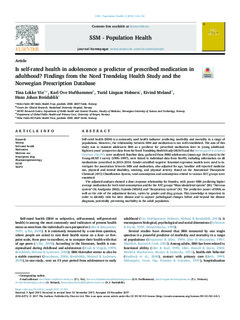| dc.contributor.author | Vie, Tina Løkke | |
| dc.contributor.author | Hufthammer, Karl Ove | |
| dc.contributor.author | Holmen, Turid Lingaas | |
| dc.contributor.author | Meland, Eivind | |
| dc.contributor.author | Breidablik, Hans Johan | |
| dc.date.accessioned | 2018-08-13T12:11:40Z | |
| dc.date.available | 2018-08-13T12:11:40Z | |
| dc.date.created | 2018-01-31T18:40:24Z | |
| dc.date.issued | 2018 | |
| dc.identifier.citation | SSM - Population Health. 2018, 4 144-152. | nb_NO |
| dc.identifier.issn | 2352-8273 | |
| dc.identifier.uri | http://hdl.handle.net/11250/2557755 | |
| dc.description.abstract | Self-rated health (SRH) is a commonly used health indicator predicting morbidity and mortality in a range of populations. However, the relationship between SRH and medication is not well established. The aim of this study was to examine adolescent SRH as a predictor for prescribed medication later in young adulthood. Eighteen years’ prospective data from the Nord-Trøndelag Health Study (HUNT) and the Norwegian Prescription Database (NorPD) were analyzed. Baseline data, gathered from 8982 adolescents (mean age 16.0 years) in the Young-HUNT I survey (1995–1997), were linked to individual data from NorPD, including information on all medications prescribed in 2013–2014. Gender-stratified negative binomial regression models were used to investigate the association between SRH and medication, also adjusted for age, baseline self-reported medicine use, physical and mental disability, smoking, and physical activity. Based on the Anatomical Therapeutic Chemical (ATC) Classification System, total consumption and consumption related to various ATC groups were examined.
The adjusted analyses showed a dose–response relationship for females, with poorer SRH predicting higher average medication for both total consumption and for the ATC groups “Musculoskeletal system” (M), “Nervous system” (N; Analgesics (N02), Opioids (N02A)) and “Respiratiory system” (R). The predictive power of SRH, as well as the role of the adjustment factors, varies by gender and drug groups. This knowledge is important in order to identify risks for later disease and to capture pathological changes before and beyond the disease diagnosis, potentially preventing morbidity in the adult population. | nb_NO |
| dc.language.iso | eng | nb_NO |
| dc.publisher | Elsevier | nb_NO |
| dc.rights | Attribution-NonCommercial-NoDerivatives 4.0 Internasjonal | * |
| dc.rights.uri | http://creativecommons.org/licenses/by-nc-nd/4.0/deed.no | * |
| dc.title | Is self-rated health in adolescence a predictor of prescribed medication in adulthood? Findings from the Nord Trøndelag Health Study and the Norwegian Prescription Database | nb_NO |
| dc.type | Journal article | nb_NO |
| dc.type | Peer reviewed | nb_NO |
| dc.description.version | publishedVersion | nb_NO |
| dc.source.pagenumber | 144-152 | nb_NO |
| dc.source.volume | 4 | nb_NO |
| dc.source.journal | SSM - Population Health | nb_NO |
| dc.identifier.doi | 10.1016/j.ssmph.2017.11.010 | |
| dc.identifier.cristin | 1559581 | |
| dc.description.localcode | © 2017 The Authors. Published by Elsevier Ltd. This is an open access article under the CC BY-NC-ND license (http://creativecommons.org/licenses/BY-NC-ND/4.0/) | nb_NO |
| cristin.unitcode | 194,65,20,15 | |
| cristin.unitname | Helseundersøkelsen i Nord-Trøndelag | |
| cristin.ispublished | true | |
| cristin.fulltext | original | |
| cristin.qualitycode | 1 | |

